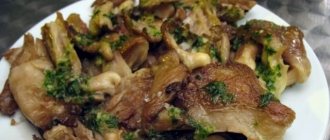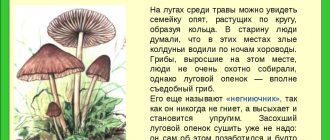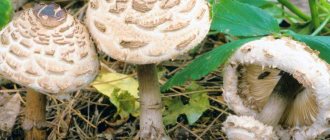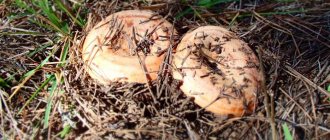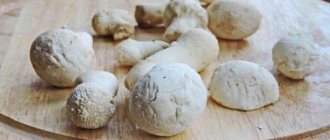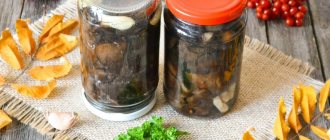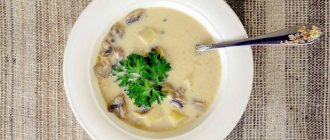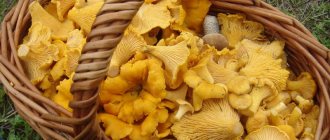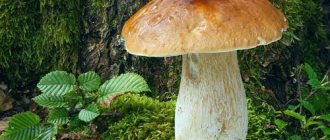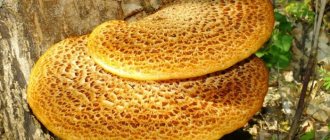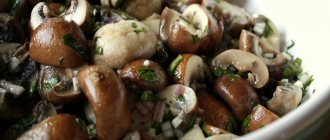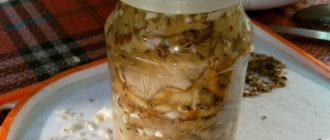Golden flake is a very healthy mushroom, so it is worth including it in your diet. Note, if you are concerned about your figure and are accustomed to low-calorie foods, then these mushrooms are definitely for you, since they contain 22 kcal per 100 g. So, to know the beneficial properties of a product, you need to study its composition. In royal mushrooms it is very rich, they contain vitamins B1, B2, B3, C and PP, as well as phosphorus, potassium, calcium and magnesium. All this wealth is wonderful for our body, because it increases overall tone and performance, improves immunity and reduces the likelihood of salt deposits in the joints.
Description of edible flake mushrooms
Mushrooms of the genus Squamos are cap-shaped.
The caps are hemispherical in young specimens and almost flat in mature ones. Their surface, yellow-brown in color, has a distinctive recognizable feature - protruding scales. It is for this feature that the mushrooms got their name. The diameter of their caps ranges from 5 to 18 cm (depending on the type). The plates on the underside of the caps are thick, adherent, and of different shades of yellow or brown. Spore powder is orange. The pulp of foliota is brown in color, has a bitter taste and smell of radish. Most representatives of this genus are inedible, only a few species are conditionally edible. Mycologists did not find any poisonous specimens among the foliots.
The mushroom stems are tall (up to 12 cm), cylindrical, often narrowing at the base, and painted the same color as the caps. Closer to the cap there is a ring of fragments of a private blanket in the form of flakes; below the ring, the legs are covered with scales.
These mushrooms grow everywhere on trees and stumps in deciduous forests, forest plantations, and parks. They bear fruit in July-November.
Golden scale, or royal honey fungus (as well as Pholiota aurivella, willow, thick or greasy scale) looks really luxurious: a large bell-shaped cap covers a thin stalk with tiny scales. The size of the mushroom is 10 - 15 cm in height, but as it grows, the cap of the golden scale reaches a truly royal size - up to 20 cm and, unlike many poisonous analogues, does not change shape as its size increases.
Description of the cap
The cap of the young mushroom is bell-shaped, 5–6 cm in diameter, yellow in color with various shades of sand or rust. On top it is covered with small flake-like scales of a darker color than the color of the cap. During further growth, the cap straightens and takes on the shape of a wide bell.
Description of the leg
The leg of the golden scale is up to 10 cm long, up to 1.5 cm in diameter, yellowish-brown in color, completely covered with felt scales of a darker color, as clearly demonstrated in the photo of the mushroom. In young representatives there is a ring on the leg, formed from a rupture. In adults there is no ring.
Royal honey fungus belongs to the fourth category of mushrooms, which is designated as having minimal value from a gastronomic point of view. However, it is not only edible, but also beneficial for human health, as it has medicinal properties. The mushroom pulp has a somewhat specific taste, which is easily eliminated after a short soaking for 2 - 4 hours.
Important! In the West, golden flake is not considered a valuable food product, but in China and Japan it is widely consumed not only for gastronomic, but also for medicinal purposes.
The most common edible types of flakes include:
- ordinary;
- golden;
- pine forest
Ordinary flake is often called fleecy. The conditionally edible mushroom has hard, snow-white flesh, which is famous for its bactericidal properties. It is often used to treat gout.
Its cap is cream-colored, spherical, and does not exceed 6 cm in diameter. The bottom is covered with a large number of plates and framed by a soft yellow blanket, which, as the mushroom grows, slides onto the stem and forms a ring.
The photo shows what a conditionally edible ordinary flake looks like. Its leg and cap are covered with brown-yellow scales.
The golden edible flake is called the royal honey mushroom due to its luxurious appearance. The yellow cap is bell-shaped, large in size and covers a thin stalk on which small scales are located. The mushroom reaches a height of 15 cm. As it grows, the cap grows to 20 cm in diameter.
The cap is covered with small, flaky, dark-colored scales that become less noticeable as it grows. There is a light felt fringe along the edge. The leg is completely covered with scales of a darker color.
A distinctive feature from its poisonous counterparts is that the shape of the cap does not change during growth.
Boris edible flake is golden, yellow, brown or orange in color. The cap often contains remnants of the coverlet. In young specimens it is hemispherical, and in adults it becomes slightly convex and spread out. The size does not exceed 10 cm. At the edges it is uneven and wavy, and a little sticky to the touch.
The cylindrical leg is dense inside, rusty or yellow in color. The odor of the edible flake is faint.
Scale is an edible mushroom, but opinions about its taste vary. Few people know that with proper preparation, the pulp, which has a specific taste, acquires a pleasant aroma and becomes similar to a porcini mushroom.
Royal honey mushrooms help turn an ordinary soup into a work of culinary art. The taste of the dish is no worse than in an elite restaurant.
You will need:
- potatoes – 460 g;
- processed cheese – 300 g;
- crackers;
- carrots – 140 g;
- water – 1.5 l;
- salt;
- vegetable oil – 40 ml;
- onion – 120 g;
- parsley;
- boiled mushrooms – 280 g.
How to cook:
- Cut the cheese into pieces or grate it.
- Chop the potatoes randomly. Grate the carrots. Chop the onion.
- Heat oil in a frying pan. Add vegetables. Fry until soft.
- Pour water into the saucepan. Throw in potatoes and mushrooms. Add some salt. Cook until done.
- Place the cheeses. Cook, stirring constantly, until dissolved.
- Add fried foods. Simmer over low heat for two minutes. Beat with a blender.
- Cook for five minutes. Serve with croutons. You can decorate with greenery.
Advice! You can’t add a lot of spices, otherwise they will overshadow the delicate flavor of the flakes.
Similar types and differences from them
Its related flakes are similar to the ordinary one:
- scaly - smaller and lighter, with a sticky whitish cap, conditionally edible;
- golden or herbal - painted golden yellow, the cap is granular without scales, the stem has a large membranous ring hanging down, has the smell and taste of bitter almonds, is considered conditionally edible, grows in abandoned settlements, on rich soils, in nettle thickets ;
- fiery - bright yellow, with lemon-colored scales and yellow-orange pulp, often has a bitter taste, especially if it grows near spruce trees, and is also classified as conditionally edible.
The autumn honey fungus (Armillaria mellea) is also similar, but it does not have large scales.
Ordinary flake, whose properties are known only to connoisseurs, forest healers and mushroom gourmets, requires mandatory cooking with preliminary boiling. Due to its wide distribution and the absence of poisonous properties even in similar species, collecting it is not only easy, but also safe.
Interesting facts about golden scale
The low content of carbohydrate substances determines their low calorie content: only 22 kcal per 100 g of mushrooms.
In addition to nutrients, the pulp of these mushrooms contains many vitamins and minerals.
Vitamins and minerals
| Name | Content per 100 g of pulp, milligrams |
| Vitamin B1 (thiamine) | 0,02 |
| Vitamin B2 (riboflavin) | 0,38 |
| Vitamin PP (nicotinic acid) | 10,3 |
| Vitamin C (ascorbic acid) | 11,0 |
| Vitamin E (tocopherol) | 0,1 |
| Potassium | 400,0 |
| Calcium | 5,0 |
| Phosphorus | 45,0 |
| Magnesium | 20,0 |
| Sodium | 5,0 |
| Iron | 0,8 |
In terms of nutritional value, edible foliots belong to the very last (fourth) food category, that is, mushrooms of mediocre taste.
Royal honey mushrooms can be used in the diet of those losing weight, this helps to avoid breakdowns during the fasting period.
The calorie content of golden flake is 22 kcal, of which:
- Proteins - 2.2 g;
- Fats - 1.2 g;
- Carbohydrates - 0.5 g;
- Dietary fiber - 5.1 g;
- Water - 89.1 g;
- Ash - 1 g.
Mono- and disaccharides per 100 g - 0.5 g.
Golden flake contains vitamins per 100 g:
- Vitamin B3 (PP) - 10.3 mg;
- Vitamin B1 (thiamine) - 0.02 mg;
- Vitamin B2 (riboflavin) - 0.38 mg;
- Vitamin C (ascorbic acid) - 11 mg;
- Vitamin E (alpha tocopherol) - 0.1 mg;
- Vitamin PP (Niacin equivalent) - 10.7 mg.
Minerals per 100 g:
- Calcium - 5 mg;
- Magnesium - 20 mg;
- Sodium - 5 mg;
- Potassium - 400 mg;
- Phosphorus - 45 mg;
- Iron - 0.8 mg.
This is not the entire useful composition. Golden flake contains folic and nicotinic acid, a tocopherol complex, and many amino acids.
Amino acids per 100 g:
- Threonine - 0.107 g;
- Leucine - 0.12 g;
- Lysine - 0.107 g;
- Valine - 0.232 g;
- Alanine - 0.199 g;
- Aspartic acid - 0.195 g;
- Glutamic acid - 0.343 g.
The action of nutrients is as follows:
- Vitamin B3 lowers cholesterol, stimulates the production of sex hormones, neutralizes dangerous substances, lowers blood sugar, breaks down proteins from food, and promotes the absorption of nutrients.
Vitamin B2 stimulates the production of hemoglobin, accelerates metabolic processes at the intercellular and intracellular levels, normalizes the functioning of the central and peripheral systems, and improves the function of the reproductive organs.
We invite you to familiarize yourself with the most delicious recipes for marinated butter without sterilization
Vitamin C is involved in all oxidative and reduction processes, increases the body's protective functions, protects the walls of blood vessels from cholesterol deposits and the nervous system from stress.
Vitamin P relieves vascular spasms, regulates cholesterol levels, eliminates intoxication, reduces the level of triglycerides in the blood, neutralizes viruses, and increases the protective functions of the thyroid gland.
Magnesium strengthens the structure of muscle and nervous tissue, stimulates the growth and restoration of soft tissue at the cellular level, prevents the deposition of stones in the kidneys and bile ducts, improves bone structure and digestive functions.
Potassium regulates water and electrolyte balance, normalizes the functioning of the cardiovascular system, is responsible for the absorption of magnesium, and controls the level of sodium chloride.
- Phosphorus, a protein component, is responsible for the metabolism of proteins, carbohydrates, lipids and proteins, and is involved in biosynthesis.
Royal honey mushrooms are used for culinary purposes; they are used as an ingredient in fungotherapy preparations. The properties of a mushroom growing in different conditions do not change, but the taste may vary. Golden flakes collected in coniferous forests may taste a little bitter, but in deciduous forests they taste pleasant, the flesh can even be sweetish.
The benefits of golden flake were noticed not only by healers, but also by those who regularly include mushrooms in the seasonal menu and prepare them for the winter.
Effect on the body:
Improves impulse conduction in nerve fibers regardless of the depth;
They have bacterial and antifungal activity due to mucus, which is located on the surface of the cap and is absorbed into the pulp;
Eliminate lethargy, fatigue, increase overall tone and performance;
Help strengthen the immune system, stimulate the production of phagocytes;
Prevent the occurrence of strokes and heart attacks by stabilizing cerebral circulation;
Reduce the likelihood of developing thrombophlebitis, atherosclerosis and varicose veins;
Improves general condition in diabetes;
The pulp of the fruiting body of royal honey mushrooms contains the substance squarrosidine, which inhibits the enzyme xanthine oxidase - because of it, urate salts are deposited in the joints. If you have a history of gout, it is recommended to eat honey mushrooms at least 4 times a week. This will help reduce the frequency of attacks and lessen the pain if they do occur.
The main contraindications to golden flakes are the inability to collect them. If the basket is filled with mushrooms grown in an environmentally polluted area or near busy roads, there is a high risk of developing intoxication. Fruit bodies absorb heavy metal salts, toxins and carbon monoxide.
Royal honey mushrooms should not be included in the diet for pancreatitis and diseases of the stomach or intestines in the acute stage - if the condition improves, one-time use does not affect the health.
Children under 3 years of age and pregnant women should not feast on golden flakes. Children do not have enough enzymes for processing, and during pregnancy you should choose lighter foods and not put yourself at risk - the accumulation of harmful substances is impossible to predict.
An absolute contraindication to the use of royal honey mushrooms is individual intolerance to mushrooms or fruiting bodies of this species.
Golden flakes do not combine with alcohol. With heavy alcoholic libations, these mushrooms are not suitable for snacks.
Abdominal cramps and pain, nausea and vomiting;
Difficulty breathing and tachycardia;
Severe intoxication causes coma and disorder of consciousness - if severe symptoms appear, it is necessary to call an ambulance.
Increased alcohol intoxication is explained by meconic acid, which is contained in the mushroom pulp. This substance is a derivative of opium. Combined action with alcohol causes dangerous symptoms.
Before preparing the main course, royal honey mushrooms require preliminary cooking. The stems are cut off almost completely, then the mushrooms are soaked for at least 20 minutes to completely remove debris and insects that have gotten into the plates. Then they are boiled in salted water and placed in a colander to drain excess moisture.
Golden flake recipes:
- Pickled mushrooms. The prepared mushrooms are boiled 2 more times for 20 minutes, each time rinsing with running water and adding new water. The jars are sterilized along with the lids, and at this time the marinade is boiled. Proportions: 1 kg of mushrooms, clean water - 600 ml, salt - 2 tablespoons, the same amount of sugar, 12 black peppercorns, 5 bay leaves and 9% vinegar - 2 tablespoons. Boil the marinade for 5 minutes, add 3-4 crushed large cloves of garlic, boil for another 2 minutes. Transfer the mushrooms into jars, pour boiling marinade over them and screw on the lids. The preserved food is left to cool upside down, under a blanket.
Golden flakes in sour cream. Place 1 kg of pre-prepared mushrooms in a colander or paper towels to remove remaining moisture, cut a large onion into rings and fry it in vegetable oil until golden brown. Lay out the mushrooms, fry for 15 minutes, pour half a glass of fatty, preferably country, sour cream into the frying pan, and simmer for 30 minutes.
Place the chicken in boiling water, add a whole onion to the container, and boil for 15 minutes. At this time, fry the onion-carrot mixture in a frying pan with sunflower oil, add mushrooms and also fry for 15 minutes. Remove the onion from the chicken broth, add potatoes, fry completely and cook until done. To improve the taste, use bay leaf, black and allspice peppers, and salt. It is better to sprinkle the soup already poured into bowls with herbs.
Royal honey mushrooms in a slow cooker. In a modern multi-cooker pan, you can pre-cook royal honey mushrooms and prepare the main dish. The washed mushrooms are placed in a bowl, set to stew for 30 minutes, and then placed on a steamer. While the liquid is draining, chop the onions and carrots.
Salad with golden flakes. Boiled chicken fillet is marinated in soy sauce. Boil the potatoes, cut into cubes, cut the carrots. The pickled mushrooms are washed and cut into equal pieces. Mix potato cubes with carrots, mushrooms and fillet pieces. A large onion is cut into rings, each ring is rolled in flour, fried until golden brown, the parsley is washed and torn by hand. The salad is decorated with fried onion rings and parsley sprigs.
Golden scale (Pholiota cerifera) is an edible mushroom.
Description of the leg
Chemical composition
The low content of carbohydrate substances determines their low calorie content: only 22 kcal per 100 g of mushrooms.
In addition to nutrients, the pulp of these mushrooms contains many vitamins and minerals. Vitamins and minerals
| Name | Content per 100 g of pulp, milligrams |
| Vitamin B1 (thiamine) | 0,02 |
| Vitamin B2 (riboflavin) | 0,38 |
| Vitamin PP (nicotinic acid) | 10,3 |
| Vitamin C (ascorbic acid) | 11,0 |
| Vitamin E (tocopherol) | 0,1 |
| Potassium | 400,0 |
| Calcium | 5,0 |
| Phosphorus | 45,0 |
| Magnesium | 20,0 |
| Sodium | 5,0 |
| Iron | 0,8 |
In terms of nutritional value, edible foliots belong to the very last (fourth) food category, that is, mushrooms of mediocre taste.
Recipes for golden flake dishes
- flakes – 700 g;
- flour – 1000 g;
- milk – 500 g;
- butter – 100 g;
- onions – 2 pcs.;
- chicken eggs – 2 pcs.;
- sugar – 50 g;
- vegetable oil – 50 ml;
- fresh yeast – 30 g;
- salt - to taste.
- Dissolve yeast in warm milk, sift 500 g of flour. Mix the products, cover the dough with a towel and place it in a warm place for 30 minutes.
- Add eggs, melted butter, salt and sugar. Add the remaining flour.
- Knead the dough and let it stand warm for 2.5-3 hours.
- Boil the mushrooms, drain the broth. Cut the onion into half rings. Fry the prepared products in vegetable oil, salt the filling to taste.
- Pass the mushrooms and onions through a meat grinder.
- Divide the risen dough into lumps with a diameter of 5 cm, roll them out with a rolling pin to a thickness of 1 cm.
- Place 1 tbsp on tortillas. l. fillings, make pies.
- Place the pieces on a baking sheet and brush with beaten egg.
- Bake the treat for 30 minutes at 200°C.
Serve baked goods with tea or milk.
Boiled honey mushrooms can be used to decorate holiday salads and snacks.
The edible flakes make delicious pickled appetizers, main and first courses. It goes well with meat, vegetables and potatoes in any form. It is used to prepare aromatic stews, sauces, toppings for homemade baked goods, salads, and solyankas. For year-round use, mushrooms are pickled, dried and pickled.
Advice! Stews made from edible flakes with the addition of dairy products are especially tasty.
We invite you to find out what flowers bloom at the end of May
The preparation of flakes must begin with proper preparation, despite the fact that the mushroom is edible. First, the fruits are sorted, removing forest debris. Young specimens are left whole, but the stem of mature specimens is necessarily cut off, which becomes unsuitable for consumption.
The earthy base of the stem of young mushrooms is cut off. Using a kitchen sponge, wipe the scales off the caps. The sorted edible fruits are washed with cold water. Then they are filled with salted water and left for 1-2 hours. For 1 liter of water you need to add 20 g of salt.
Before cooking, large caps should be cut into several parts, and small ones can be left whole. Pour in water so that all the fruits are completely covered with liquid. Add salt and cook over medium heat for half an hour. During the cooking process, be sure to remove the foam, along with which the remaining debris floats to the surface. After this, change the water and cook again for half an hour.
Photos and a step-by-step description of the process will help you properly prepare the flake mushroom. Thanks to this, all the proposed options will turn out tasty and safe for everyone.
Growing
There are three ways to grow bitterlings at home.
In the garden
To do this, you need to purchase ready-made mycelium in a specialized store or prepare planting material yourself from freshly picked mushrooms.
Take the caps of the fruiting bodies (8-10 pieces), separate them from the stems, fill them with water and leave them to infuse for a day. The next day, knead them with your hands into a paste (you can rub them through a fine sieve), and mix the mushroom solution thoroughly.
In the garden, select a suitable place near birch, pine or oak trees, where bitters usually grow in nature - near the trees with which they form mycorrhizae. Remove the top layer of soil up to 20-25-30 cm thick. Purchased or homemade mycelium is mixed with a pre-prepared substrate, which includes straw, deciduous tree bark or compost.
Lay it in a thick layer - 4-5 cm, sprinkle it with garden soil on top and water it.
Further care consists of periodically moistening the soil and, if necessary, sheltering from sunlight to avoid drying out of the mycelium.
If everything is done correctly, you will receive the first harvest next year in July. The lifespan of the mycelium directly depends on the lifespan of the tree chosen for its planting.
In room
You can grow bitters not only outdoors, but also indoors - a barn or basement.
To do this, it is necessary to provide certain growth conditions:
- stable temperature within 20-21°C;
- humidity at 70-75%;
- good ventilation;
- daylight.
The bitter mushroom produces rich harvests every year. It grows abundantly throughout Russia from the first days of summer until late autumn, and can withstand light frosts on the soil, down to -5°C.
Features of the bitter mushroom
How to cook pies with golden flakes
Description of the leg
In addition to its beneficial properties, royal honey mushrooms can also have harmful effects on the human body. Their harm may be due to various factors:
- They belong to the inedible types of flakes.
- Collected in places with unfavorable environmental conditions (near landfills, cattle burial grounds, along roads, in industrial zones).
- They are overripe or wormy.
Eating edible types of flakes is contraindicated in case of individual intolerance and allergies.
With gastritis, pancreatitis, cholecystitis and kidney disorders, taking foliot in food can cause an exacerbation.
Children's age, pregnancy and breastfeeding are also absolute contraindications to eating foliot.
It is strictly forbidden to simultaneously consume royal honey mushrooms and alcoholic beverages. It has been scientifically established that when they are taken simultaneously, disulfiram-like (coprine) syndrome develops.
This syndrome manifests itself in the form of symptoms of acute intoxication with intermediate breakdown products of alcohol:
- rush of blood to the face;
- tinnitus;
- nausea and vomiting;
- abdominal pain;
- increased body temperature;
- rapid heartbeat;
- difficulty breathing;
- panic state.
The pulp of these mushrooms also contains meconic acid, which is a derivative of opium. Therefore, in some cases, when royal honey mushrooms are consumed without prior boiling, psychedelic states may develop, accompanied by auditory and visual hallucinations.
Similar types and differences from them
The common flake can be confused with other representatives of the foliota – the fiery flake and the golden flake. They are really similar in appearance, both in scales and shape. In addition, their fruiting season may coincide. However, the fiery flake is orange in color, and the golden flake is yellow, whereas, like an ordinary flake, it remains ocher throughout its life.
The taste of fire flake is bitter, unlike golden and ordinary foliot. But even if you can’t deal with them, then there is no need to worry, none of these mushrooms contain poison and you cannot be poisoned by them.
Also, often inexperienced mushroom pickers can mistake the scales for late honey mushrooms, especially adult individuals whose scales are pressed to the surface of the cap.
Recipes for golden flake dishes
The noble taste of edible flakes is fully revealed when pickled. The classic cooking variation is considered the fastest and easiest, so any inexperienced cook will cope with the task the first time.
You will need:
- boiled edible flakes – 1 kg;
- garlic – 3 cloves;
- filtered water – 600 ml;
- bay leaf – 5 pcs.;
- salt – 40 g;
- cloves – 3 buds;
- sugar – 40 g;
- black pepper – 13 peas;
- vinegar 9% – 40 ml.
How to cook:
- To boil water. Add salt and sweeten. Stirring, cook until the products dissolve.
- Pour in vinegar. Add pepper, bay leaves and cloves.
- Crush the garlic cloves and add to the marinade. Cook for seven minutes.
- Place the still warm boiled mushrooms in sterilized jars and pour over the marinade. Close the lids and screw tightly.
- Turn over and leave under the blanket for a couple of days.
- Store in the basement at a temperature of 6°... 8°C.
If a large harvest of edible flakes has been harvested, then it is worth salting them for the winter.
You will need:
- peppercorns – 14 pcs.;
- edible flakes – 2 kg;
- dill umbrellas – 5 pcs.;
- cloves – 3 buds;
- currant leaves – 13 pcs.;
- salt – 100 g;
- bay leaf – 5 pcs.
How to cook:
- Wash the prepared edible flake and cook for 20 minutes. Change the water. Add spices. Cook for 20 minutes.
- Place in a colander and wait until all the liquid has drained. Transfer to a pickling container.
- Sprinkle with salt. Add dill umbrellas and currant leaves. Mix.
- Cover with a cotton cloth and put pressure on top.
- Place in a cool, dark place.
Cooking features
Before preparation, the poplar row must be processed as follows:
- wash thoroughly from dirt and dust;
- then transfer to a large container, fill with cool water and soak for two to three days. This procedure must be carried out to get rid of bitterness;
- When soaking, the water must be changed periodically - at least twice a day;
- When the mushroom caps become elastic and do not break when pressed with your fingers, you can begin further processing.
For consumption, this mushroom can be fried, stewed with sour cream, salted, pickled, or canned. There are many recipes for preparing first and second courses from poplar rows. Let's look at the most popular of them.
Recipe: pickled poplar rows
The pickled row has an excellent taste.
Ingredients
For marinating, the following ingredients are taken per liter of marinade:
- poplar row;
- common salt - 2 tablespoons;
- granulated sugar - 2 tablespoons;
- vinegar essence - 3 teaspoons;
- bay leaf, dill to taste;
- black peppercorns - 10 pieces;
- allspice cloves - 6 pieces;
- water for marinade - 1 liter.
Cooking method
Soaked and well-washed mushrooms are thrown into a pan of water, salted and boiled for about 15 minutes. Then the water is poured out and new water is poured in, and boiled for another 45-50 minutes. After the time has passed, transfer the mushrooms to a colander. At the same time prepare the marinade. The marinade is made based on the proportions for a 10-liter bucket of mushrooms: 1.5 liters. To do this, pour water, add salt, sugar, seasonings and cook for 15 minutes, adding vinegar essence at the end.
At the same time, jars and nylon lids previously washed with soda are sterilized. Place the boiled mushrooms in the jars with their caps facing down and pour in the marinade until it is filled to the brim. Then put a lid on top, cool and place in the refrigerator. After a month, these pickled mushrooms are ready.
Recipe: salting poplar row
Pickling mushrooms can be done either cold or hot.
Ingredients
For hot pickling you need to take the following ingredients:
- poplar row - 1 kg:
- salt - 50 g;
- medium-sized onion - 1 pc.;
- garlic - 4 large cloves;
- dried dill, a bunch of tarragon, horseradish root - to taste.
Cooking method
For this purpose, select whole, not overgrown mushrooms. The row, previously thoroughly washed, is boiled in salted water for at least half an hour. Then transfer to a colander and rinse in cool water. Well-washed glass jars are sterilized.
Boiled mushrooms are placed in a jar, salt and all the spices are thrown in. Mushrooms are placed in jars as tightly as possible. Instead of cans, you can take a tub and put pressure on top. You can try it in a week.
With the cold pickling method, mushrooms are soaked for at least three days. The ingredients are the same as for the hot method, but you need to take more salt - 5% of the total weight of the row. After soaking, the rows are thoroughly washed, placed on a sieve and waited for the water to drain.
The jars are sterilized and the bottom is sprinkled with salt. If mushrooms are salted in a tub, then boiling water is poured over it and the bottom is also sprinkled with salt.
Did you know? During the growth period, the internal pressure of the fungus can reach seven atmospheres, so it can even break through iron or marble.
In a row of salt in jars or tubs, these mushrooms are placed with their stems facing up in two layers and covered with salt. And so on until the end of the container. Then, instead of lids, take wooden circles and cover them on top.
Sterile gauze folded several times is placed under these circles. A load is placed on top. As soon as the mushrooms settle, add another row.
After 7 days, a brine forms on the surface. If such a brine does not appear, then the pressure on top should be increased with more weight, the container should be covered with polyethylene, and the dishes should be placed in the cold. The row will be ready in about 40 days.
Use in folk medicine
Medicinal products (decoctions, infusions, tinctures) are prepared from foliots, which are used by traditional healers in the treatment of diseases of the cardiovascular system (atherosclerosis, arterial hypertension, varicose veins, thrombophlebitis). Iron and magnesium foliot help increase hemoglobin levels, so introducing these mushrooms into the diet will be useful for anemia and thyroid diseases.
Thanks to the large amount of fiber in the pulp, royal honey mushrooms prevent constipation. The presence of squarrosidine in the pulp of royal mushrooms makes them an indispensable food for people suffering from gout. Moth preparations are used in folk medicine as an emetic and laxative.
Due to its low calorie content, royal mushrooms are included in the diet of diabetics, vegetarians and dieters. It has been scientifically proven that fresh golden foliot extract inhibits the growth of Ehrlich carcinoma and sarcoma-180 in laboratory mice.
Only ordinary, golden, gum-bearing foliots and nameko honey mushrooms are used in cooking, because they have pulp with a pleasant smell and a typical mushroom taste, similar to the taste of real honey mushrooms.
These mushrooms can be prepared in different ways:
- add to soups, main courses, baking fillings, sauces and salads;
- fry;
- marinate;
- salt.
It is not customary to dry the flakes.
You should not prepare fresh foliots: they can cause dyspeptic symptoms. Before cooking, royal honey mushrooms must be boiled to avoid these digestive problems. The mushroom broth must be drained.
You can eat the entire fruiting body of the mushroom, but experienced chefs recommend using the caps for hot dishes, and the whole body for pickles and pickling.
A variety of floodplains
Strictly speaking, there are no varieties of floodplains. There are more than 2,500 species of the family Ordinaceae. Some of them are considered varieties of the same mushroom. The following rows can be taken for undertopolnik:
- crowded;
- gray;
- earthy;
- green;
- brown;
- leopard print
Since these species have a similar growth mechanism (almost underground), they are often mistaken for varieties of floodplains. The fact that the growing places, descriptions and photos of these mushrooms do not coincide with sandpipers is of little concern to anyone. At most, they will be called a false sandpiper/row.
Comment! Podtopolnik is also called the value mushroom.
Most likely for the appearance. But the valui has not the slightest relation to the ordinary ones: it is a family of Russula. The photo shows not one of the types of floodplains, but a valui. He's a bull. It is enough to cut off the fruiting body to understand the difference: the stem of the row is dense, while that of the valuu is hollow.
Flakes fried with sour cream
When fried, mushrooms turn out porous and meaty. To enhance their taste, sour cream is added to the composition.
You will need:
- boiled edible flake – 800 g;
- pepper;
- vegetable oil – 40 ml;
- onion – 350 g;
- salt;
- sour cream – 250 ml.
How to cook:
- Place mushrooms in a frying pan. Fry without closing the lid until the moisture evaporates.
- Cut the onions into half rings. Pour into the pan. Pour in the oil. Add some salt. Cook over medium heat, stirring constantly, until the vegetable is golden brown.
- Pour in sour cream. Mix. Sprinkle with pepper. Cook for seven minutes.
Advice! To make the taste of the dish more delicate, vegetable oil can be replaced with butter.
Beneficial features
The pulp of royal honey mushrooms is good for health, because with its low calorie content it contains the entire spectrum of essential amino acids, and in terms of the amount of phosphorus and calcium it is comparable even to fish fillet.
Due to the presence of iron and magnesium in the pulp, these mushrooms participate in the processes of hematopoiesis, normalize the conduction of impulses along nerve fibers, influence the synthesis of proteins in the human body and are catalysts for various chemical reactions.
Substances exhibiting bactericidal and antifungal effects were found in golden, gum-bearing and edible foliots. The mucus covering the surface of the fruiting bodies of golden and edible scales has the following properties:
- stimulate cerebral circulation;
- increase immunity;
- relieve fatigue;
- restore vitality.
The flakes contain squarrosidine, a unique compound that inhibits the enzyme xanthine oxidase. The enzyme xanthine oxidase promotes the crystallization of uric acid in the joints, kidneys and body tissues. By inhibiting this enzyme, squarrosidine prevents the precipitation of urate salts and thus prevents painful attacks in people with gout. In clinical practice, drugs containing a xanthine oxidase inhibitor as an active substance are used to treat gout.
There is evidence that products made from these mushrooms can exhibit anti-cancer properties.
conclusions
Scales are not very popular mushrooms among Russian mushroom pickers. Of the 30 species of foliot that grow in the deciduous forests of Russia, only three are edible and can be eaten along with other edible mushrooms. These are ordinary, golden and gum-bearing flakes.
These mushrooms contain all the nutrients, vitamins and minerals necessary for the human body. Due to their chemical composition, they have beneficial properties for the circulatory system, digestive organs, metabolism and hematopoiesis. Can be taken as a treatment for gout.
In terms of their nutritional value, foliots are mushrooms of the fourth category. Before cooking, they must be boiled, and only then added to first and second courses, salads, sauces, baked goods, fried, pickled, and salted.
If used incorrectly, edible foliots can also exhibit harmful properties. The most dangerous condition can develop in people who drink alcohol at the same time as these mushrooms - this is coprine syndrome, severe intoxication. In severe cases, collapse, coma and even death can occur.
| Name: | Scaly |
| Type: | Edible |
Edible scale is not particularly popular among mushroom pickers. Undeservedly, the mushroom is often classified as poisonous. In fact, this species has not only high taste, but also healing properties.
Where do autumn royal mushrooms grow?
It is worth noting that edible species of royal honey mushrooms grow on damaged tree trunks and old, long-cut stumps.
They can also be found on the ground next to the roots of dead deciduous and coniferous trees. Fruiting of golden scales or royal honey mushrooms begins in August and continues until the end of September. Residents of the Primorsky Territory can collect these amazing mushrooms from mid-May to mid-September. Where else do royal honey mushrooms grow, and which trees are preferred most? Typically, this species of honey mushrooms settles on the trunks of deciduous trees, especially alder or willow; sometimes it chooses birch trees and birch stumps, less often – coniferous trees in wetlands. Look at the photos below showing what royal honey mushrooms look like on trees in the forest:
Sometimes even experienced mushroom pickers, due to the rare appearance of golden scales, confuse them with false honey mushrooms, which grow in the same areas. Therefore, we suggest that you carefully read the photos of edible and false royal honey mushrooms:
As mentioned, scale mushrooms or king mushrooms are edible mushrooms. However, before using it, it must be boiled in salted water for 20-25 minutes. Since royal honey mushrooms have excellent taste, they are used in appetizers, salads, first and second courses. The flakes go especially well with fried or boiled potatoes. In addition, many housewives make preparations for the winter from these mushrooms: pickled, salted, frozen and dried.
Sometimes honey mushrooms can be found in pine forests and spruce forests. What does the royal honey fungus look like if you find it in a coniferous forest? Typically, scales collected in deciduous forests differ from those growing in coniferous forests. The first difference between honey mushrooms found in pine forests is the dark color of the cap and scales, and the second is the bitter taste. However, royal honey mushrooms contain a lot of vitamin C, PP and E. In addition, there are only 22 calories per 100 g of flakes, so the calorie content of this species is very low. That is why they are useful for vegetarians and those who follow a low-calorie diet. In terms of phosphorus and calcium content, royal honey mushrooms even compete with fish.
Experts have classified royal honey mushrooms as category IV of edibility. That is why in other countries they are not eaten or even collected, since this category abroad refers to inedible species. However, in Russia they are prepared in the same way as ordinary autumn mushrooms. They are first boiled in salted water and only then fried, stewed or cooked as first courses. In addition, royal autumn honey mushrooms are used in other culinary recipes: they prepare mushroom stew, julienne, make caviar, pates, sauces, solyankas and mushroom fillings for pizzas and pies.
Although golden flake is widespread in Russia and is well recognized, it is not collected so often. This may be due to the fact that this type of mushroom is not familiar to many people. However, real connoisseurs of mushroom delicacies put it on a par with autumn honey mushrooms and even boletus mushrooms. We invite you to watch a video of royal honey mushrooms being collected in deciduous forests by lovers of “silent hunting”:
